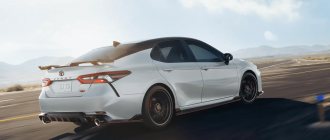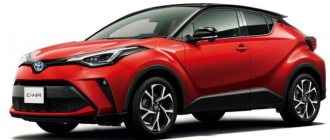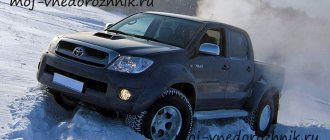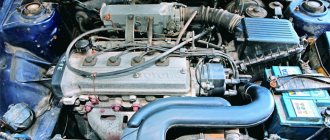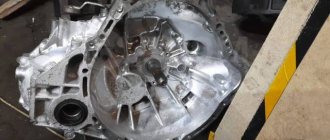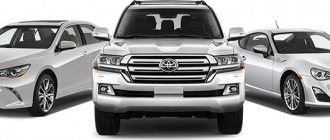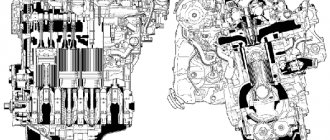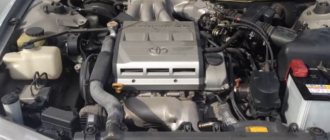3453 Apr 20
The Japanese brand Toyota and its Camry model in the V40 body are a business class sedan. The car rolled off production lines in Australia, the USA, China, Japan and Russia. The car was produced from 2006 to 2009 and this was already the seventh generation for the model. The Camry was traditionally produced with front-wheel drive, however, an all-wheel drive version was released for the Japanese market. Such equipment was not assembled in any other country.
During the creation process, the exterior of this generation Camry acquired slightly different features than were customary to see on the “Japanese” of previous versions. The car acquired originality and recognition due to the new rounded body shapes and elongated, narrowed headlights, which tell where the sedan comes from.
Logbook Toyota Camry 3.5 (2008)
So, dear readers, I have owned a Toyota Camry in a 40 body with a 3.5 engine, American-made, for exactly a year. The car was manufactured in 2008, at the time of purchase in January 2021, according to the odometer readings, it was 135,000 miles; at the time of writing the review, the mileage was 155,500 miles. I deliberately did not write reviews about this car because at first the emotions were from wow to this, a complete scribe). I decided to put in more mileage after posting my opinion.
And so... let's start with sensations... and since everything is learned by comparison, I will compare it with the cars that I owned and still own to this day. these will be volkswagen passat B5+ (still available to this day) and Mercedes benz W203 (sold - reviews available). Of course, the W203 does not fit into the framework of a family sedan, but we will compare it with what we have.
Let's start with the positives. 1 plus the Camry is the size of the interior...much larger than in the Passat (even larger than in the Mercedes W210 W211 and W212 (I didn’t drive in the 213, I don’t know). The 2nd plus is of course the engine...3.5 in its segment (aspirated engines of the same volume ) I think it has no equal. But the car is not for racing, I’ll tell you right away. The 3rd plus for me is the impressiveness of the suspension, not the softness like on Mercs, but the impressiveness.
Now the downsides... the quality, materials and selected texture of the interior trim... cannot be compared with the 203 Mercedes, but even with the Passat... the wood trim (already normal and not yellow) of the lining on the doors and the central tunnel is compatible (although rather completely not compatible) with silver center console trim and turquoise head unit lighting. The plastic on top is even more or less soft (but harder than that of the Passat), everything below...like a Chinese toy for 3 dollars. At night...of all the buttons (not counting the center console), only the heated seats are illuminated; neither the overhead lamp nor the power windows (and only the driver's automatic) are not illuminated.
Obesshumka...it’s not there))) honestly, the car is a little quieter than the VAZ 2109))). a simple example: on 203 at a speed of 150 km/h on an asphalt highway, you can calmly talk on the phone, they can hear you and you without raising your voice. Passat, up to about 120 km/h you can also talk calmly. in a Camry at a speed of 80 km/h on a concrete road, neither the interlocutor nor you can really hear you, you have to yell. There doesn’t seem to be anything rattling or knocking, but there’s just no noise reduction. In winter, by the way, the front panel creaks. You can hear everything under the wheels very clearly, including stones and water and everything, everything. The wheels themselves are the same, although the price is soft. When it rains, the drumming on the roof is very distinct. if a person is standing a meter away from you and talking on the phone in a calm tone... you can hear what he is saying with the windows closed)). You can, of course, make a complete noise reduction... but you still can’t make a Mercedes out of it, and I don’t see the point in carrying an extra 100 kg of noise reduction.
The next minus is the side windows and windshield are not athermal... that is, you are driving along the highway with a Conder in the summer towards the sun, it seems cool and the sun is baking your chest. gasoline consumption...believe it or not, in the summer the city is from 11 liters/highway from 6 liters, in the winter from 15 liters the city. On average I have 12-13 liters in the city in the summer, thanks to the engine and 6-speed automatic transmission. Since there is no need to turn the engine above 2000 rpm even when starting from a stop, the torque is enough for the eyes. In the city, the revs very rarely rise above 2000. But if you press the gas pedal as hard as you can (from each traffic light, a slipper to the floor until the next one) in 22 km (the distance from home to work) you can burn a quarter of the tank))).
Once again, the car is not for racing, but for a sedate, imposing drive, since the handling... well, wadded... when the car is pushed to the floor, even with the stabilization system turned on, it grinds and strives to jump out of the trajectory. when driving sedately, you can’t hear the engine at all, the gears are switched imperceptibly, there is no need to stoke the engine... that is, a smooth forward movement... like in German taxis... anyone who has driven will understand. overall comfort...if not for the lack of noise reduction. Well, basically everything I remembered.
And now the main advantage of this car is the availability of all spare parts at affordable prices. upon purchase, the rear left strut, bushings and front stabilizer struts were replaced. it all cost 5,000 rubles))) not original but still in use. for example, for the same spare parts for the W203, Lemfederovsky gave 22,000 rubles. In the summer, two lambda probes on the left bank were ordered to last a long time... they were not available (the city is small) or universal ones (without a guarantee for 3 rubles each) or original ones for 10,000 rubles each - but as the servicemen said, how long will they last on our gasoline is a question open. I figured that for 4 sensors (the other two, too, when the thread is covered) I would have to pay 40,000 rubles... this is not the car to invest that much... they upgraded it to EURO 0 (without lambda mode) for 12,000 rubles with the condition that you drive for 3 months, if you don’t like it, we’ll return everything back. Nothing has changed either in dynamics or in consumption; I drive like this. not so long ago the VSC error came on, diagnostics revealed a coil leak on cylinder 3 (no problem), but since it’s on the interior side... you need to remove the manifold... either 4 rubles from servicemen for the work... or yourself in 2-3 hours. I decided that in order not to climb right away a second time, I would have to change all the spark plugs, there are 12 of them, the coil costs 3 rubles. I decided to leave it until spring when it gets warmer.
In general, this is a spacious family sedan for comfortable (if not for noiselessness) movement from point A to point B... anyone who expects adrenaline like from a Bimmer or a smooth ride, high-quality finishing materials and a feeling of silence like in a coffin in a Mercedes... the car will disappoint. For those who don’t believe in gas mileage, I’m attaching a couple of photos at what speed and how many rpm.
at 80 km/h 1500 rpm
at 100 km/h 1800 rpm
at 150 km/h 2800 rpm
6th generation review
High-quality interior of the 40th body.
Most of the versions that dominate the market now are dealer versions. Their production has been established in Russia since 2008, and they are well adapted to local conditions. There are also quite a few copies exported from the Middle East and the USA on the secondary market.
But this option is not worth taking, since they have weak anti-corrosion treatment. The climate system and cooling are designed for hot climates.
Toyota Camry V40 sedans were sold in Russia, well adapted to the road conditions of our country.
All models are distinguished by a rich set of equipment:
- the basic Comfort model has 6 airbags, climate control, air ionizer;
- Comfort Plus was equipped with a five-speed gearbox;
- Elegance has leather seats and parking radar;
- Prestige – it has cruise control, xenon headlights and stability control;
- Luxury – equipped with a six-speed gearbox, V6 engine
The Toyota Camry 40 body is loved by domestic motorists and in its class has a large lead in sales compared to competitors, not having the best driving performance or design in its class.
Toyota Camry with a powerful V6 3.5 engine.
The machine is popular due to its high quality workmanship and durability. This model has low maintenance costs, is easy to repair and can be sold quickly at a good price.
Image in an especially large size: test drive of Toyota Land Cruiser 200 TRD
The monitor of the multimedia system is docked to the “tidy” (which one no longer dares to call such), creating the full impression of a common screen.
The image displayed on it, at the request of the driver and front passenger, can be divided into two parts. Such a touch from the “premium”.
By poking your finger at this “smartphone”, you can completely customize the car for yourself, use the multimedia capabilities of the Bose audio system (“it rocks” - very much!), and also deal with a whole set of “individualizations”. Including lighting on the doors - 64 colors. The system can be forced to change them independently, depending on the driving mode.
By the way, I was amused by the shape of the automatic transmission selector handle (the arsenal includes either a 6-speed or a more modern 8-speed automatic).
Here it was stylized as an airplane engine control lever - the throttle in the pilot's cockpit. Near it there was a “puck” for switching the car’s driving modes - from the vegetable “eco” to the peppy “sport”.
Another pleasant thing is that the K5 now has a heated windshield, which was not present on the Optima. The luxurious Webasto panoramic sunroof on the entire roof did not “eat up” part of the height of the cabin, and even provided passengers with beautiful views, not to mention rapid ventilation of the cabin at any speed. In addition, due to the lack of sunlight in our latitudes, a “panorama” will come in very handy - both for health and for mood.
But rear riders should rejoice at the changes in the dimensions of the D1 class sedan in the KIA line. As mentioned above, the wheelbase of the car increased by 45 mm, to 4905 mm, the trunk volume remained at the Optima level - more than 500 liters. That is, from lengthening the car, first of all, the knees of the rear riders benefited.
I don’t know who it is, but to me the back seat of the K5 seemed as spacious as in the Skoda Superb, which is considered one of the trendsetters in the class in this regard.
Image in an especially large size: test drive of Toyota Land Cruiser 200 TRD
The monitor of the multimedia system is docked to the “tidy” (which one no longer dares to call such), creating the full impression of a common screen.
The image displayed on it, at the request of the driver and front passenger, can be divided into two parts. Such a touch from the “premium”.
By poking your finger at this “smartphone”, you can completely customize the car for yourself, use the multimedia capabilities of the Bose audio system (“it rocks” - very much!), and also deal with a whole set of “individualizations”. Including lighting on the doors - 64 colors. The system can be forced to change them independently, depending on the driving mode.
By the way, I was amused by the shape of the automatic transmission selector handle (the arsenal includes either a 6-speed or a more modern 8-speed automatic).
Here it was stylized as an airplane engine control lever - the throttle in the pilot's cockpit. Near it there was a “puck” for switching the car’s driving modes - from the vegetable “eco” to the peppy “sport”.
Another pleasant thing is that the K5 now has a heated windshield, which was not present on the Optima. The luxurious Webasto panoramic sunroof on the entire roof did not “eat up” part of the height of the cabin, and even provided passengers with beautiful views, not to mention rapid ventilation of the cabin at any speed. In addition, due to the lack of sunlight in our latitudes, a “panorama” will come in very handy - both for health and for mood.
But rear riders should rejoice at the changes in the dimensions of the D1 class sedan in the KIA line. As mentioned above, the wheelbase of the car increased by 45 mm, to 4905 mm, the trunk volume remained at the Optima level - more than 500 liters. That is, from lengthening the car, first of all, the knees of the rear riders benefited.
I don’t know who it is, but to me the back seat of the K5 seemed as spacious as in the Skoda Superb, which is considered one of the trendsetters in the class in this regard.
But I was surprised by the strangeness. Koreans seem to have been so carried away by beauty and style that they have forgotten about the smallest but necessary detail for comfort in the back.
They provided a couple of USB connectors for the people who found themselves here, but forgot the banal knob for adjusting the intensity of air flow from the climate system deflectors.
